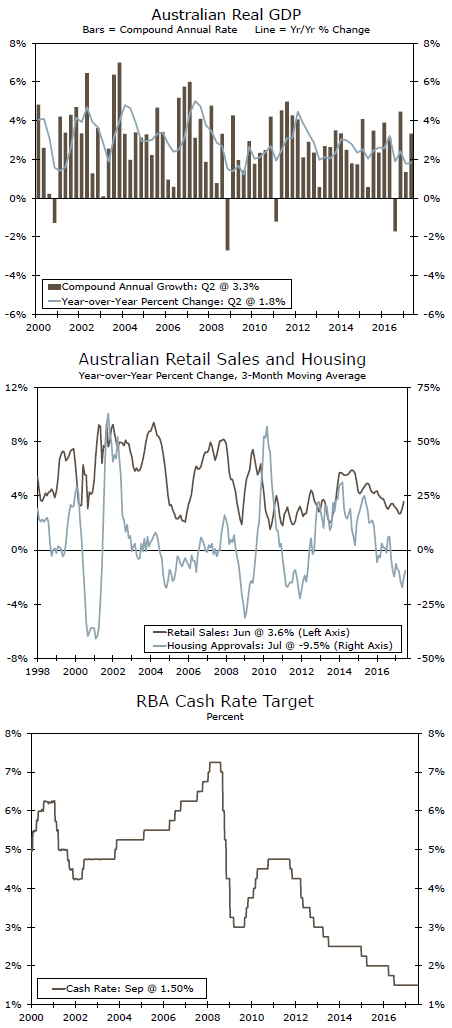Second quarter GDP growth came in a bit below expectations, but the headline miss is largely a function of an inventory drawdown. Final domestic demand actually posted its second best quarter in five years.
Inventories Mostly to Blame
According to data released earlier today, the Australian economy picked up speed in the second quarter but, the 0.8 percent growth achieved during the quarter (not annualized) was a tick shy of the 0.9 percent that had been expected. Still, at an annualized rate, the 3.3 percent growth marks a more than doubling of the 1.3 percent growth reported in the first quarter, and is also faster than the 2.5 percent average quarterly growth rate achieved in 2015 and 2016.
The soft print hides what we consider to be a marked improvement in growth fundamentals. Consumer spending, for example, quickened modestly versus the prior period which is consistent with three consecutive monthly gains in retail sales during the quarter. A more demonstrable example of the improvement is in gross fixed capital formation which increased 1.5 percent (not annualized) the second-fastest quarterly pop since 2012.
The primary culprit for the miss in second quarter GDP growth in Australia was a drawdown in inventories. Coming on the heels of a modest inventory build in the first quarter, the result was a big drag on headline GDP which masks the improvement in domestic demand. Indeed, our calculation of final domestic demand (which sums government, consumer and business spending, but excludes trade and inventories) shows an annualized growth rate of 3.8 percent. That is the second-best outturn for final domestic demand in the past five years.
Consistent with what we have seen in other trade-reliant economies, some firming in global growth was supportive of trade during the quarter as well. Exports increased 2.7 percent for the quarter and imports increased as well, but the 1.2 percent growth there was not nearly as much as exports which resulted in a boost to the headline from trade.
RBA Still Stuck in a Bind
The Reserve Bank of Australia (RBA) also met today and as widely expected kept the official cash rate at 1.5 percent where it has been for a little over a year now. As we wrote in a recent piece with our colleagues in the currency strategy group, Catch-22, the RBA is stuck in the unsavory position of rising consumer debt amidst a run-up in home prices, at least in some markets. What has arguably changed in the roughly four months since we published that report is that there are signs of firming in the Aussie economy. Acknowledging this dynamic, the official statement from the RBA noted "[t]he recent data have been consistent with the Bank’s expectation that growth in the Australian economy will gradually pick up over the coming year." With inflation still low and wobbly fundamentals in housing, we still see the RBA on hold well into 2018.












